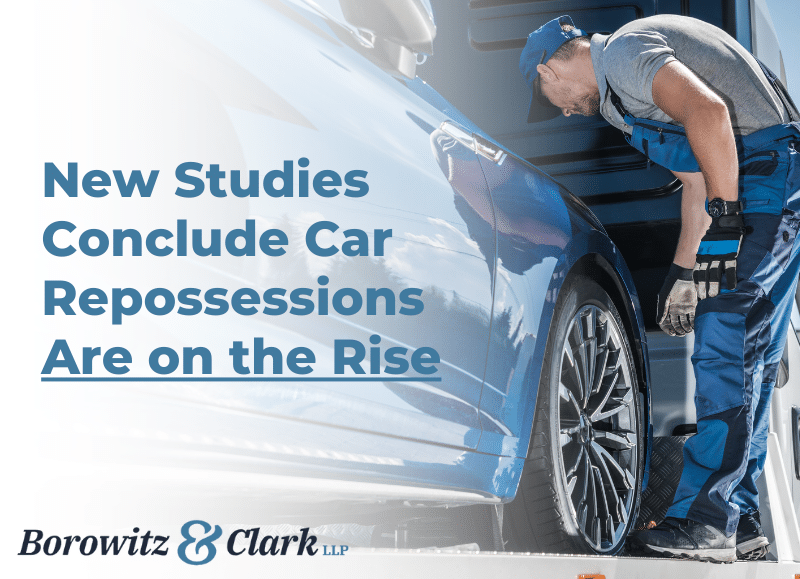In 2020, automobile repossessions in Los Angeles County were down 34% from the previous year–a six-year low. But, experts predicted that would change–in Los Angeles and around the country. With the pandemic ongoing, employment down, and no new government relief on the horizon, many foresaw a surge in vehicle repossessions. But, there was additional government relief, in the form of extended and enhanced unemployment compensation, more stimulus payments, rental assistance, student loan freezes, and more. 
Table of Contents
Those added supports extended into 2021, as the job market quickly recovered and unemployment declined dramatically. So, the anticipated increase in repossessions didn’t happen on schedule.
It’s happening now. And, it’s happening at a bad time for most Americans. Here’s a look at what’s driving the surge in repossession and auto loan delinquencies and what likely lies ahead.
New and Used Car Prices Remain High
New car prices are up, and inventory is low due to supply chain issues. That’s pushed the price of used cars up dramatically. California saw some of the most significant increases in the country. The national average year-over-year increase in auto prices from January 2021 to January 2022 was 36.9%, and a few states had increases below 29%. But, the average price of an automobile in California grew by 39.7%. Just six states saw bigger increases.
Recently, used car prices have dipped slightly. Still, June prices were about 12% higher than during the same period the previous year. And, for many models, the price increase is even more dramatic–sometimes more than 40%.
Even though prices have declined slightly, affordability continues to decline. The average used car price remains high, at more than $28,000, and inventory is especially low for cars priced at under $10,000. In June, the median number of weeks of income required to purchase a new vehicle increased to 42.2 weeks–that means more than 80% of annual income.
Auto Delinquencies and Repossessions in 2022
Subprime auto repossessions are up 11% from 2020. That’s bad news, but not necessarily surprising or alarming to experts. Subprime loans are higher-cost loans written to riskier borrowers. They typically default at higher rates than prime loans.
Now, though, prime borrowers are suffering, too. Their share of vehicle repossessions has doubled, though it remains small compared with subprime borrowers. But, not all borrowers have been equally impacted. Delinquency rates have increased most significantly among Gen Z borrowers, closely followed by Millennials.
Pandemic Era Purchasing
Americans, including those in California, spent a lot of money on cars in 2020 and 2021. In the first quarter of 2020, when concern over Covid-19 was just beginning, Americans owed an aggregate $1.168 trillion in automobile loans. That probably sounds like a lot, but two years later, in the first quarter of 2022, that number stood at $1.47 trillion–an increase of more than $300 billion, or about 47%.

An expert tip from Erik
That huge increase didn’t just come from people buying more cars, but from people buying more expensive cars and financing more of their purchases. From the fall of 2020 to the fall of 2021, the average automobile loan balance increased between 3.8% and 8%, depending on the state. In California, the increase was 7.6%, from $19,550 to $21,027. Nationwide the average monthly payment on a new car loan increased by 11.8% from 2020 to 2021, and used car loan payments jumped by 18.2%.
In part, the rising amount of outstanding auto debt, larger loans, and larger payments is attributable to increased cash flow during the pandemic. A combination of stimulus money, other supports, and temporary relief from certain debts such as student loan payments meant many household budgets actually improved during the pandemic. And, some experts say, that made some buyers overly optimistic.
Then, economic circumstances changed. The last stimulus check went out in the spring of 2021 and enhanced unemployment benefits terminated in the fall. Most people returned to work, and average wages increased slightly. But, at the same time, the price of critical consumer goods, such as groceries and gasoline, was climbing. Housing costs increased. Household budgets tightened, making it harder to keep up those car payments. One dealer reported that most of the repossessed cars he was seeing go to auction had been purchased in 2020 and 2021–a deviation from the usual pattern.
What to Do If You’re Facing Repossession
If you’re one of the many Americans having trouble making your car loan payments, it’s time to explore your options. Some of the usual solutions may be temporarily off the table for some people. For example, low vehicle inventory–especially at the less expensive end of the spectrum–and high prices will make it harder for those who may have overcommitted on their car payments or experienced a reversal to replace their cars with less expensive alternatives. But, you may still have options.
The earlier you educate yourself about how to avoid repossession, your rights if your vehicle is repossessed, and what happens after repossession, the better. Here’s some key information about California repossessions to get you started:
Still have questions? Our attorneys are dedicated to helping people in and around Los Angeles manage debt and regain control of their finances. We offer free consultations for people facing repossession and other financial difficulties. To schedule yours, just call 877-439-9717 or fill out the contact form on this page right now.
